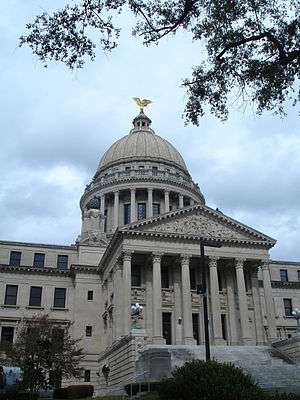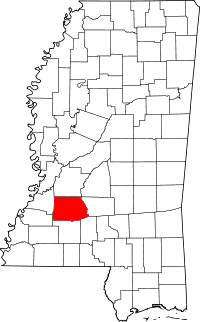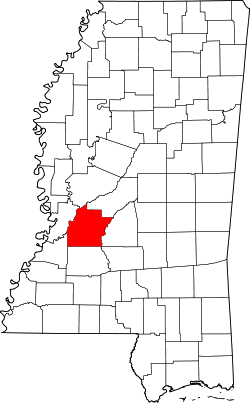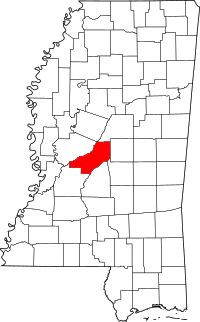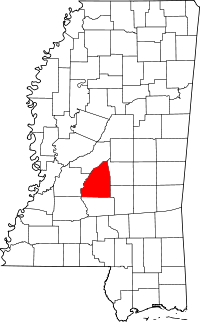Jackson metropolitan area, Mississippi
The Jackson, MS Metropolitan Statistical Area is a metropolitan area in the central region of the U.S. state of Mississippi that covers five counties: Copiah, Hinds, Madison, Rankin, and Simpson. As of the 2010 census, the MSA had a population of 539,057. According to 2018 estimates, the metro area's population has increased to 580,166.[1]
Communities
Places with more than 25,000 inhabitants
- Jackson (Principal City)
- Jackson is the capital and the most populous city of the State of Mississippi. It is one of the county seats of Hinds County (Raymond being the other). As of the 2010 census Jackson's population was 173,514. 2016 estimates show a slight decrease to 169,148.[1]
- Clinton
- Madison
- Pearl
Places with 1,000 to 10,000 inhabitants
Places with fewer than 1,000 inhabitants
Unincorporated places
|
Demographics
As of the census[2] of 2000, there were 497,197 people, 180,556 households, and 127,704 families residing within the MSA. The racial makeup of the MSA was 53.02% White, 45.29% African American, 0.13% Native American, 0.67% Asian, 0.02% Pacific Islander, 0.29% from other races, and 0.60% from two or more races. Hispanic or Latino of any race were 0.98% of the population.
History
Founding and antebellum period (to 1860)

The area that is now Jackson was initially referred to as Parker'ville.[3] A trading post was set up there by Louis LeFleur, a French Canadian trader, on the historic Natchez Trace trade route. This was before the Choctaw ceded land under the Treaty of Doak's Stand in 1820, and the US formally opened the area for settlement by non-Native American settlers.
The city was founded to establish a centrally located capital for the new state of Mississippi. In 1821, the Mississippi General Assembly, meeting in the then-capital of Natchez, had sent Thomas Hinds, James Patton, and William Lattimore to look for a site. After surveying areas north and east of Jackson, they proceeded southwest along the Pearl River until they reached LeFleur's Bluff in Hinds County. Their report to the General Assembly stated that this location had beautiful and healthful surroundings, good water, abundant timber, navigable waters, and proximity to the trading route Natchez Trace. And so, a legislative Act passed by the Assembly on November 28, 1821, authorized the location to become the permanent seat of the government of the state of Mississippi.
Jackson is named after the seventh President of the United States, Andrew Jackson (pictured to the right), in recognition for his victory in the Battle of New Orleans.
Jackson was originally planned, in April 1822, by Peter Van Dorn in a "checkerboard" pattern advocated by Thomas Jefferson, in which city blocks alternated with parks and other open spaces, giving the appearance of a checkerboard. This plan has not lasted to the present day.
The state legislature first met in Jackson on December 23, 1822.
In 1839, Jackson was the site of the passage of the first state law that permitted married women to own and administer their own property.
Jackson was first linked with other cities by rail in 1840. An 1844 map shows Jackson linked by an east-west rail line running between Vicksburg, Raymond, and Brandon. Unlike Vicksburg, Greenville, and Natchez, Jackson is not located on the Mississippi River, and did not develop like those cities from river commerce. Instead, railroads would later spark growth of the city in the decades after the American Civil War.
American Civil War and late nineteenth century (1861–1900)
Despite its small population, during the Civil War, Jackson became a strategic center of manufacturing for the Confederate States of America. In 1863, during the campaign which ended in the capture of Vicksburg, Union forces captured Jackson during two battles—once before the fall of Vicksburg and once after the fall of Vicksburg.
On May 13, 1863, Union forces won the first Battle of Jackson, forcing Confederate forces to flee northward towards Canton. Subsequently, on May 15, 1863, Union troops under the command of William Tecumseh Sherman burned and looted key facilities in city of Jackson, a strategic manufacturing and railroad center for the Confederacy. After driving the Confederate forces out of Jackson, Union forces turned west once again and engaged the Vicksburg defenders at the Battle of Champion Hill in nearby Edwards. The siege of Vicksburg began soon after the Union victory at Champion Hill. Confederate forces began to reassemble in Jackson in preparation for an attempt to break through the Union lines surrounding Vicksburg and end the siege there. The Confederate forces in Jackson built defensive fortifications encircling the city while preparing to march west to Vicksburg.
Confederate forces marched out of Jackson to break the siege of Vicksburg in early July 1863. However, unknown to them, Vicksburg had already surrendered on July 4, 1863. General Ulysses S. Grant dispatched General Sherman to meet the Confederate forces heading west from Jackson. Upon learning that Vicksburg had already surrendered, the Confederates retreated back into Jackson, thus beginning the Siege of Jackson, which lasted for approximately one week. Union forces encircled the city and began an artillery bombardment. One Union artillery emplacements is still intact on the grounds of the University of Mississippi Medical Center in Jackson. Another Federal position is still intact on the campus of Millsaps College. One of the Confederate Generals defending Jackson was former United States Vice President John C. Breckinridge. On July 16, 1863, Confederate forces slipped out of Jackson during the night and retreated across the Pearl River. Union forces completely burned the city after its capture this second time, and the city earned the nickname "Chimneyville" because only the chimneys of houses were left standing. The northern line of Confederate defenses in Jackson during the siege was located along a road near downtown Jackson, now known as Fortification Street.
Today there are few antebellum structures left standing in Jackson. One surviving structure is the Governor's Mansion, built in 1842, which served as Sherman's headquarters. Another is the Old Capitol building, which served as the home of the Mississippi state legislature from 1839 to 1903. There the Mississippi legislature passed the ordinance of secession from the Union on January 9, 1861, becoming the second state to secede from the United States. The constitutional convention of 1890, which produced Mississippi's Constitution of 1890, was also held there. The so-called New Capitol replaced the older structure upon its completion in 1903, and today the Old Capitol is a historical museum. A third important surviving antebellum structure is the Jackson City Hall, built in 1846 for less than $8,000. It is said that Sherman, a Mason, spared it because it housed a Masonic Lodge, though a more likely reason is that it housed an army hospital.
Early twentieth century (1901–1960)
Pulitzer Prize-winning author Eudora Welty was born in Jackson in 1909, died there in 2001, and lived most of her life in the Belhaven section of the city. She wrote a memoir of her development as a writer, One Writer's Beginnings (1984), which gives a charming picture of the city in the early 20th century. Today, the main Jackson public library is named in her honor.
Highly acclaimed African-American author Richard Wright, a native of Roxie, Mississippi, lived in Jackson as an adolescent and young man in the 1910s and 1920s, and relates his experience in his memoir Black Boy (1945). He describes the harsh and largely terror-filled life most African-Americans experienced in the South and the rest of the United States under segregation in the early twentieth century.
Jackson's economic growth was stimulated in the 1930s by the discovery of natural gas fields nearby.
During World War II, Hawkins Field in northwest Jackson became a major airbase. Among other facilities and units, the Royal Netherlands Military Flying School was established there, after Nazi Germany occupied the Netherlands. From 1941, the base trained all Dutch military aircrews.
Civil rights era and afterwards (1961–present)
Since 1960, Jackson has undergone a series of dramatic changes and growth. On May 24, 1961, during the American Civil Rights Movement, a large group of Freedom Riders was arrested in Jackson for "disturbing the peace" after they disembarked from their bus. Although the Freedom Riders had planned to make New Orleans their final destination, Jackson was the farthest that any of them actually managed to travel.
In Jackson, shortly after midnight on June 12, 1963, Medgar Evers, civil rights activist and leader of the Mississippi chapter of the NAACP, was murdered by Byron De La Beckwith, a white supremacist. In 1994, prosecutors Ed Peters and Bobby DeLaughter finally got De La Beckwith convicted of murder by a jury. A portion of U.S. Highway 49, all of Delta Drive and Jackson-Evers International Airport now bear Medgar Evers's name.
The first successful cadaveric lung transplant was performed at the University of Mississippi Medical Center in Jackson in June 1963 by Dr. James Hardy. Hardy transplanted the cadaveric lung into a patient suffering from lung cancer. The patient survived for eighteen days before dying of kidney failure.
In June 1966, Jackson was also the terminus of the James Meredith March, organized by James Meredith, the first African-American to enroll at the University of Mississippi. The march, which began in Memphis, Tennessee, was an attempt to garner support for the Civil Rights Movement and was accompanied by a drive to register African-Americans to vote in Mississippi. In this latter aim, it succeeded in registering between 2,500 and 3,000 black Mississippians to vote. The march ended on June 26 after Meredith, who had been wounded by a sniper's bullet earlier on the march, addressed a large rally of some 15,000 people in Jackson.
Since 1968, Jackson has been the home of Malaco Records, one of the leading record companies for gospel and soul music in the United States. In January 1973, Paul Simon recorded the song "Learn How To Fall", found on the album There Goes Rhymin' Simon, in Jackson at the Malaco Recording Studios.
Two students at Jackson State University (then called Jackson State College) were killed while protesting the Vietnam War on May 15, 1970. These murders were part of the evidence cited by Newsweek in its issue of 18 May when it suggested that U.S. President Richard Nixon faced a new home front.
In 1997, Harvey Johnson Jr. became the city's first African American mayor. During his term, he proposed the creation of a convention center, in hopes of attracting business to the city. This measure was passed during Johnson's tenure, but construction did not begin until recently. The convention center has an anticipated completion date of early 2009. Mayor Johnson was replaced by Frank Melton on July 4, 2005. Melton has subsequently generated controversy through his unconventional behavior, which has included acting as a law enforcement officer. A dramatic spike in crime has also ensued, despite Melton's promises to rid the city of its crime problem.[4]
Geography and climate
The Jackson metropolitan area possesses a humid subtropical climate, with very hot, humid summers and mild winters. Rain is very evenly spread throughout the year, and snow can fall in wintertime, although heavy snowfall is relatively rare. Much of the areas rainfall occurs during thunderstorms. Thunder is heard on roughly 70 days per annum. The Jackson metropolitan area lies in a region prone to severe thunderstorms which can produce large hail, damaging winds and tornadoes.
Religion
- Many different denominations are represented in Jackson. Jackson is the episcopal see of the Roman Catholic Diocese of Jackson and of the Episcopal Diocese of Mississippi.
Industry
Jackson is home to several major industries. These include electrical equipment and machinery, processed food, and primary and fabricated metal products. The surrounding area supports agricultural development of livestock, soybeans, cotton, and poultry.
Publicly traded companies
The following companies are headquartered in Jackson:
- Cal-Maine Foods, Inc. (NASDAQ:CALM)
- EastGroup Properties Inc. (NYSE:EGP)
- Knobias (otcbb: KBAS)
- Trustmark Corporation (NASDAQ:TRMK)
Cultural organizations and institutions
- Ballet Mississippi
- Celtic Heritage Society of Mississippi
- Crossroads Film Society
- Jackson State University Botanical Garden
- Jackson Zoo
- Mississippi Agriculture and Forestry Museum
- Mississippi Art Center
- Mississippi Children's Museum
- Mississippi Chorus
- Mississippi Department of Archives and History, which contains the state archives and records.
- Mississippi Heritage Trust
- Mississippi Immigrants Rights Alliance
- Mississippi Hispanic Association
- Mississippi Museum of Art
- Mississippi Opera
- Mississippi Symphony Orchestra (MSO), formerly the Jackson Symphony Orchestra, founded in 1944
- Municipal Art gallery
- Mynelle Gardens
- New Stage Theatre
- Russell C. Davis Planetarium
- Smith-Robertson Museum and Cultural Center
Education
Colleges and universities
- Belhaven University (Jackson)
- Copiah-Lincoln Community College (Wesson)
- Hinds Community College (Raymond)
- Holmes Community College (Ridgeland)
- Jackson State University (Jackson)
- Millsaps College (Jackson)
- Mississippi College (Clinton)
- Reformed Theological Seminary (Jackson)
- Tougaloo College (Jackson)
- Tulane University (Madison)
- University of Mississippi Medical Center (Jackson)
- Wesley Biblical Seminary (Jackson)
- Wesley College (Florence)
- Delta Technical Technical College Ridgeland, Mississippi www.deltatechnicalcollege.com
Public school districts
- Canton Public School District (serves the city of Canton)
- Clinton Public School District (serves the city of Clinton)
- Copiah County School District (serves Copiah County)
- Hazlehurst City School District (serves the city of Hazlehurst)
- Hinds County School District (serves Hinds County outside of the Jackson city limits)
- Jackson Public School District (serves the city of Jackson)
- Madison County School District (serves Madison County)
- Pearl Public School District (serves the city of Pearl)
- Rankin County School District (serves Rankin County)
- Simpson County School District (serves Simpson County)
Private schools
- Hillcrest Christian School (Jackson)
- Jackson Academy (Jackson)
- Jackson Preparatory School (Flowood)
- Madison-Ridgeland Academy (Madison)
- Magnolia Speech School (Jackson)
- St. Andrew's Episcopal School (Ridgeland -Middle and Upper Schools; Jackson – Lower School)
- St. Joseph Catholic School (Madison)
- The Veritas School (Jackson)
Media
Newspapers
Daily
- The Clarion-Ledger statewide general interest newspaper, at http://www.clarionledger.com
Weekly
- Jackson Advocate, weekly newspaper and oldest newspaper serving the state's African-American community, at http://www.jacksonadvocate.com
- Jackson Free Press – alternative newspaper, with focus on politics, entertainment and culture; blogs and discussion at http://www.jacksonfreepress.com
- La Noticia de Mississippi – Voz de la Comunidad Latina – The Mississippi Hispanic Newspaper at http://www.lanoticianewspaper.com/
- The Mississippi Link weekly statewide general interest newspaper, focusing on the African American community, at http://www.mississippilink.com
- Mississippi Business Journal weekly newspaper, with focus on business and economic development, at http://www.msbusiness.com
- The Northside Sun weekly newspaper, with focus on the northeastern portion of the Jackson Metropolitan area, at http://www.northsidesun.com
- B Fit and Healthy Magazine, Health and Fitness Magazine for Mississippians, at http://bfitandhealthymagazine.com
Historic
- The Jackson Mississippian, circulated during the 19th century
Publishing
- University Press of Mississippi, the state's only not-for-profit publishing house and collective publisher for Mississippi's eight state universities, producing works on local history, culture and society
Television
- Channel 3, WLBT: NBC
- Channel 8, WBXK: America One
- Channel 10, WBMS: independent (simulcast of WXMS)
- Channel 12, WJTV: CBS
- Channel 16, WAPT: ABC
- Channel 23, W23BC: independent (owned and operated by Jackson State University)
- Channel 27, WXMS: independent
- Channel 29, WMPN: PBS/Mississippi Public Broadcasting
- Channel 34, WRBJ-TV: TBN
- Channel 35, WLOO: My Network TV
- Channel 40, WDBD: Fox
- Channel 49, WJXF-LP: Retro Jams
- Channel 53, WJMF-LP: Univision
FM radio
|
|
Points of interest
Tourism and Culture
Jackson is a city famous for its music – including gospel, blues and R&B. Jackson is also home to the world famous Malaco Records recording studio. Many notable musicians hail from Jackson.
Jackson is home to the USA International Ballet Competition. Founded in 1978 by Thalia Mara, the first USA International Ballet Competition took place in 1979 and joined the ranks of Varna, Bulgaria (1964); Moscow, Russia (1969); and Tokyo, Japan (1976). The International Ballet Competition (IBC) originated in Varna, Bulgaria in 1964. The competition eventually expanded to rotating annual events in Varna, Moscow and Tokyo. In 1979 the event first came to the United States in Jackson, Mississippi, where it now returns every four years. The rotation is currently among Jackson, Varna, Helsinki, Finland and Shanghai, China. These first competitions were given sanction by the International Dance Committee of UNESCO's International Theater Institute. Today, international ballet competitions flourish worldwide, and the USA IBC in Jackson remains one of the oldest and most respected competitions in the world. In 1982, the United States Congress passed a Joint Resolution designating Jackson as the official home of the USA International Ballet Competition. Jackson held subsequent competitions in 1982, 1986, 1990, 1994, 1998, 2002, 2006 and 2010. The next competition is in 2014. The competitions are held at Thalía Mara Hall.[5]
Downtown Jackson Renaissance
Currently, Jackson is experiencing $1.6 billion in downtown development. Among the projects include improvements to or construction of the following:
- Old Capital Green
- Pinnacle at Jackson Place
- Convention Center and Hotels
- Mississippi Telecom Center
- Events Center/Sports Arena
- Union Station
- Farish Street Neighborhood Historic District
- Standard Life Building
- Electric 302
- Plaza Building
- AT&T Building
- Jackson Place Residential
- State and Tombigbee Lofts
- Library Lofts
- Towncreek Apartments at Farish
- Ceva Green
- King Edward
- Mississippi History Museum
- Festival Park
- Old Capital Museum
- Mill Street Viaduct and Market
- Cellular South
- JPD Headquarters
- New Federal Courthouse
- Mississippi Museum of Art
Downtown Jackson Attractions
- Alamo Theater (The)
- Boddie Mansion (The)
- Bronze Statue of Medgar Evers
- Mississippi State Capitol
- Municipal Art Gallery
- Dr. A. H. McCoy Federal Building
- Mississippi Supreme Court
- Russell C. Davis Planetarium/Ronald E. McNair Space Theater
- Oaks House Museum
- Sonny Guy Municipal Golf Course
- Thalia Mara Hall / City Auditorium
- War Memorial Building
- Smith Park
- Smith Robertson Museum and Cultural Center
- Chimneyville Crafts Gallery
- City Hall
- Mississippi Arts Center
- Mississippi Department of Archives and History
- Mississippi Fairgrounds Complex
- Mississippi Governor's Mansion
- Mississippi Museum of Art
- Jackson Zoological Park is located on the cusp of downtown Jackson and is one of the finest zoological parks in the South.
Tallest buildings
| Name | Height | Year |
|---|---|---|
| AmSouth Plaza | 97 m | 1975 |
| Jackson Marriott Downtown | 78 m | 1975 |
| AmSouth Bank Building | 77 m | 1929 |
| Standard Life Building | 76 m | 1929 |
| Trustmark National Bank Building | 66 m | 1955 |
| Lamar Life Building | 58 m | 1924 |
Museums
- Eudora Welty House Museum
- Manship House Museum
- Medgar Evers Home Museum
- Mississippi Agriculture and Forestry Museum
- Mississippi Children's Museum
- Mississippi Museum of Art
- Mississippi Museum of Natural Science
- Mississippi Sports Hall of Fame and Museum – The Museum was rated the 8th best Museum for American Baseball History in the United States by an ESPN writer – ranking ahead of the Negro League Museum in Kansas City and the St. Louis Cardinal's Museum in St. Louis.
- The Oaks House Museum/Boyd House
- Smith Robertson Museum and Cultural Center
- The City of Jackson Fire Museum and Public Fire Safety Education Center
- The International Museum of Muslim Cultures
Historic sites
- Old Capitol Museum of Mississippi History
- Mississippi Governor's Mansion
- Manship House Museum
- The Oaks House Museum/Boyd House
- King Edward Hotel
- Standard Life Insurance Building
- Greenwood Cemetery
Fondren is a historical neighborhood located just North of downtown Jackson. The district has the ambiance of art-deco style architecture and many fine restaurants and eclectic shops.
Periodic cultural events
- Mississippi State Fair (annual, held in October)
- Crossroads Film Festival (annual, April)
- Jubilee! Jam (annual, June)
- CelticFest Mississippi (annual, September)
- Festival Latino (annual, September)
- OUToberfest (annual gay and lesbian festival, October)
- USA International Ballet Competition (every four years, June)
- Mals St. Pattys Day Parade (annual, on the Saturday of or after March 17, the fourth largest in the nation with over 50,000 people)
Entertainment Venues
- Hal and Mal's – Blues, R&B, Soul, variety; 200 S. Commerce St. in downtown
- Gators Downtown – 105 E. Capitol St. in downtown
- 930 Blues Cafe – Blues; 930 N. Congress St. in downtown
- Fenian's Irish Pub – Irish music with live bands and DJ; 901 E. Fortification St.
- Freelon's Bar and Groove – R&B, Hip-Hop; 440 N. Mill St.
- El Jardin de las Aves – Latin music featuring live bands and DJs; 1075 South Frontage Road
- La Cotorra Taqueria Mexicana – Mexican music with live bands (often La Sonora Dinamita) and DJs; 1999 Hwy 80 W.
- Jala Jala Night Club – Latin music played by DJs; 2662 Hwy 80 W.
- Fire – Live Music, Rock, Dance Club/BBQ & Sports Bar; 209 S. Commerce St. in downtown
Parks
- LeFleur's Bluff
- Battlefield Park
- Parham Bridges Park
- Sheppard Brothers Park
- Smith Park
- Sykes Park
- Grove Park
- Laurel Park
- Poindexter Park
Sports
Sports teams in the Jackson Metro area
- Mississippi Braves—minor league baseball affiliate (AA) of the Atlanta Braves. The team plays at Trustmark Park in Pearl, Mississippi.
- Mississippi Brilla—minor league soccer team in the Premier Development League. The team plays at Clinton High School in Clinton, Mississippi.
Summer Training Camp
- New Orleans Saints, Jackson's Millsaps College is the former summer home for the New Orleans Saints of the NFL from 2006–2010
Sports venues in the Jackson Metro area
- Mississippi Veterans Memorial Stadium—Concerts, Football (home of Jackson State University)
- Mississippi Coliseum—Basketball, Hockey, Track, Rodeo, Concerts
- Smith Wills Stadium—Baseball, Softball, Football, Soccer, Concerts
- Trustmark Park—Baseball
- Parham Bridges—Tennis
Professional Events
- Sanderson Farms Championship-PGA TOUR
Former professional sports teams
- Baseball
- Jackson Senators, Independent (2001–2004)
- Jackson Diamond Kats of the independent Texas–Louisiana League (2000)
- Jackson Generals, former Texas League AA affiliate of the Houston Astros (1991–1999)
- Jackson Mets, former Texas League AA affiliate of the New York Mets (1975–1990)
- Basketball
- Jackson Wildcats, United States Basketball League
- Mississippi Rage, World Basketball Association
- Mississippi Hardhats, World Basketball Association
- Hockey
- Jackson Bandits -- East Coast Hockey League
- Soccer
- Jackson Calypso—Women's Soccer
- Jackson Rockers—Men's Soccer
- Jackson Chargers—Men's Soccer
- Football
- Mississippi Pride -- Regional Football League
- Las Vegas Posse -- Canadian Football League—As a historical note, the team almost moved to Jackson, but efforts to relocate the team to Mississippi failed.
Transportation
Air travel
Jackson is served by Jackson-Evers International Airport, located at Allen C. Thompson Field, east of the city in Flowood in Rankin County. Its IATA code is JAN. The airport has non-stop service to 12 cities throughout the United States and is served by 6 mainline carriers (American, Delta, United, and US Airways)
On 22 December 2004, Jackson City Council members voted 6-0 to rename Jackson International Airport in honor of slain civil rights leader and NAACP field secretary for Mississippi, Medgar Evers. This decision took effect on 22 January 2005.
Formerly Jackson was served by Hawkins Field Airport, located in northwest Jackson, with IATA code HKS, which is now used for private air traffic only.
Underway is the Airport Parkway project. The environmental impact study is complete and final plans are drawn and awaiting Mississippi Department of Transportation approval. Right-of-way acquisition is underway at an estimated cost of $19 million. The Airport Parkway will connect High Street in downtown Jackson to Mississippi Highway 475 in Flowood at Jackson-Evers International Airport. The Airport Parkway Commission consists of the Mayor of Pearl, the Mayor of Flowood and the Mayor of Jackson, as the Airport Parkway will run through and have access from each of these three cities.
Ground transportation
Interstate highways
![]()
Runs north-south from Chicago through Jackson towards Brookhaven, McComb, and the Louisiana state line to New Orleans. Jackson is roughly halfway between New Orleans and Memphis, Tennessee. The highway maintains eight to ten lanes in northern part of city, six lanes in the center and four lanes south of I-20.
![]()
Runs east-west from near El Paso, Texas, to Florence, South Carolina. Jackson is roughly halfway between Dallas, and Atlanta. The highway is six lanes from Interstate 220 to MS 468 in Pearl.
![]()
Connects Interstates 55 and 20 on the north and west sides of the city and is four lanes throughout its route.
U.S. highways
![]()
Runs north-south from the Arkansas state line at Lula via Clarksdale and Yazoo City, towards Hattiesburg and Gulfport. It bypasses the city via I-20 and I-220
![]()
Known in Jackson as State Street, roughly parallels Interstate 55 from the I-20/I-55 western split to downtown. It multiplexes with I-55 from Pearl/Pascagoula St northward to County Line Road, where the two highways split.
![]()
Roughly parallels Interstate 20.
State highways
![]()
Runs southwest towards Raymond, Utica, and Port Gibson; southeast towards Bay Springs and Quitman.
![]()
Some parts of this road are known as Lakeland Drive, which runs northeast towards Carthage and Starkville.
Other roads
In addition, Jackson is served by the Natchez Trace Parkway, which runs from Natchez to Nashville, Tennessee.
Bus service
JATRAN (Jackson Transit System) operates hourly or half-hourly during daytime hours on weekdays, and mostly hourly on Saturdays. No evening or Sunday service is operated.
Railroads
Jackson is served by the Canadian National Railway (formerly the Illinois Central Railroad). The Kansas City Southern Railway also serves the city. The Canadian National has a medium-sized yard downtown which Mill Street parallels and the Kansas City Southern has a large classification yard in Richland. Amtrak, the national passenger rail system, provides service to Jackson. The Amtrak station is located at 300 West Capitol Street. Amtrak's southbound City of New Orleans provides service from Jackson to New Orleans and some points between. The northbound City of New Orleans provides service from Jackson to Memphis, Carbondale, Champaign-Urbana, Chicago and some points between. Efforts to establish service with another Amtrak train, the Crescent Star, an extension of the Crescent westward from Meridian, Mississippi, to Dallas, Texas, failed in 2003.
See also
- Mississippi census statistical areas
- List of metropolitan areas in Mississippi
- List of micropolitan areas in Mississippi
- List of cities in Mississippi
- List of towns and villages in Mississippi
- List of census-designated places in Mississippi
- List of United States metropolitan areas
References
- "U.S. Census website". United States Census Bureau. Retrieved 2019-09-20.
- "U.S. Census website". United States Census Bureau. Retrieved 2008-01-31.
- "WorldWeb.com Travel Guide". Archived from the original on 2008-07-06. Retrieved 2007-09-30.
- Associated Press (July 27, 2006). "Mayor of U.S. city failing the hard test of crime prevention". Taipei Times. Retrieved 2007-03-09.
- "USA International Ballet Competition". Archived from the original on 2007-09-25. Retrieved 2007-09-30.
